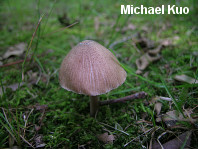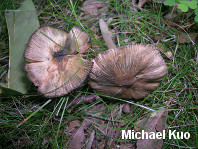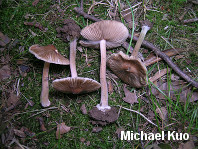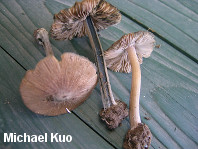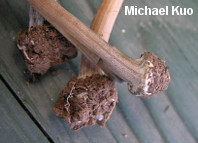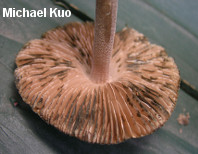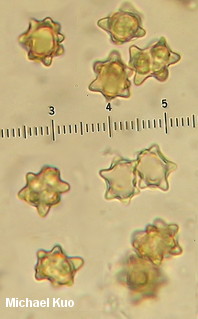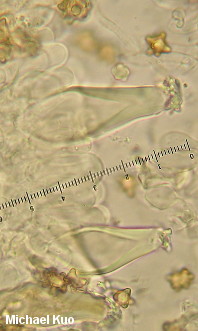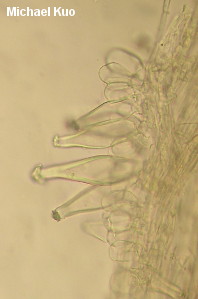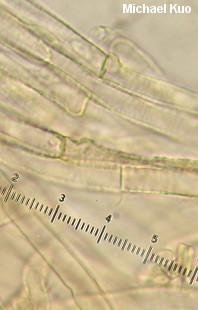| Major Groups > Gilled Mushrooms > Dark-Spored > Inocybe > Inocybe insignis |

|
Inocybe insignis [Basidiomycota > Agaricales > Inocybaceae > Inocybe . . . ] by Michael Kuo In August of 1939, mycologist Alexander H. Smith collected a fascinating and distinct species of Inocybe under American beech and eastern hemlock in Tennessee, in Great Smoky Mountains National Park. Smith found only one small specimen, but because it was very distinct he published it two years later (1941) as a new species, Inocybe insignis, easily recognized by the combination of blue-staining surfaces and nodulose, star-shaped spores. Presumably because Inocybe insignis was known only from the original type collection and was, therefore, rare and insufficiently documented, Smith included the species in his popular field guide, How to Know the Gilled Mushrooms (Smith, Smith & Weber, 1979), hoping that collectors would document the species and eventually work out its distribution. And then . . . nothing happened. It may be that Inocybe insignis was collected and correctly identified over the next three decades—but if so, no one documented any collections or preserved them in any of our nation's major herbaria. The next record of the species is the collection you see illustrated here, made by my wife and me in a central Illinois campground, under oaks and hickories in 2011. Four years later I found the species again, several counties away from the first Illinois collection. Since then, collections have been sent to me from Indiana and Virgina, extending the range of the species. So I am repeating Smith's strategy, including Inocybe insignis on this website in the hope that others will discover the species and document further collections. Please don't hesitate to contact me if you suspect you have collected a match; I will be happy to study your collection (preserved specimens will be needed) and, if it's a match, add its data to what is known about this apparently rare species. Thanks to Brandon Matheny for his expertise and patience. Thanks to Cody Morgan and Ron Kerner for collecting, documenting, and preserving Inocybe insignis; their collections are deposited in The Herbarium of Michael Kuo. Description: Ecology: Presumably mycorrhizal; growing alone, scattered, or gregariously; originally collected under American beech and eastern hemlock, but my collections have been made under oaks and hickories; summer and fall; distribution uncertain (known from Illinois to Tennessee). The illustrated and described collections are from Illinois, Indiana, and Virginia. Cap: 3–6 cm; conic at first, becoming broadly conic to broadly bell-shaped; dry; silky at first, becoming radially fibrillose and, over the center, very finely scaly; dull medium brown; bruising and discoloring greenish blue. Gills: Narrowly attached to the stem; close; short-gills frequent; buff at first, becoming dull cinnamon brown; edges colored like the faces; staining or slowly bruising greenish blue. Stem: 5–7 cm long; 3–4 mm thick; more or less equal above a rimmed, bulbous base; dry; silky; dull brown to pinkish brown; bruising greenish blue to blackish blue. Flesh: Whitish; unchanging, or slowly staining greenish blue when sliced. Odor: Strong and sweet, with a spermatic component. Chemical Reactions: KOH negative on cap surface. Spore Print: Dull brown. Microscopic Features: Spores 8–11 x 6–9 µm; sub-elliptic or subcruciate in outline; stellate or prominently nodulose, with 7–11 conic nodules visible; yellowish to brownish in KOH; orangish in Melzer's reagent; not cyanophilic. Pleurocystidia 50–65 x 15–23 µm; mostly widely lageniform; apically encrusted with crystals; thick-walled; hyaline to golden in KOH. Cheilocystidia similar but smaller. Basidia 30–34 x 9–11 µm; 4-sterigmate. Lamellar trama parallel. Caulocystidia similar to pleurocystidia. Pileipellis a radial cutis; elements brownish- to brown-walled in KOH, smooth or finely encrusted, 2–7 µm wide, clamped. REFERENCES: A. H. Smith, 1941. (Smith, Smith & Weber, 1979; Kuo & Matheny, 2015.) Herb. Kuo 07101101, 06221501, 12011701, 07142103. This site contains no information about the edibility or toxicity of mushrooms. |
© MushroomExpert.Com |
|
Cite this page as: Kuo, M. (2022, June). Inocybe insignis. Retrieved from the MushroomExpert.Com Web site: http://www.mushroomexpert.com/inocybe_insignis.html |
